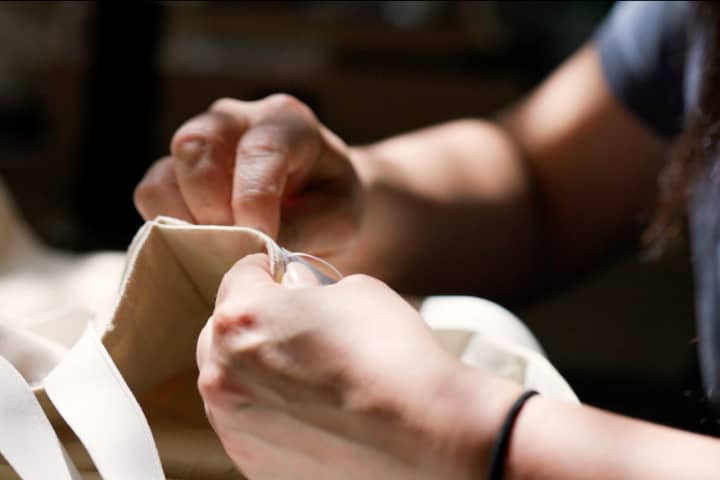For the set of As You Like It, set and costume designer Alicia Clements says she and director Simon Phillips ‘wanted to create a forest that was as sprawling, lush and evocative of the natural world’ as they possibly could. Creating such a naturalistic landscape on stage is challenging, but solving problems like this is what MTC’s production department does best.
Once Clements had finalised the set design concept, MTC’s CAD (computer-aided design) drafter converted her design renderings into precise scale plans. These plans were used by the workshop team to construct the set in pieces, and then the scenic art team painted each piece. All the elements were then moved to the theatre for bump-in and assembled onstage. Supporting this entire process for As You Like It was Production Manager Michele Preshaw. ‘I assist the creative vision but also need to take into account the necessary financial and time constraints placed on that vision by the Company,’ says Preshaw.
Because As You Like It was originally programmed for 2020 but delayed by the COVID-19 pandemic, parts of the set had been ready and waiting for several months. While work on the Forest of Arden components continued at MTC HQ in October 2021, the flats comprising the palace walls arrived at Southbank Theatre for bump- in. ‘We commenced with laying a substrate floor, then built and flew out the flown walls including cornices and keystones,’ says Preshaw (flown walls are set elements that hang from bars in the grid above the stage, and can be lifted up out of sight). ‘We then continued downstage and built the tracking towers; then the prompt-side walls – in sections, including cornices and keystones – then the rear walls and finally the off-prompt walls. It was installed in this order to allow our Lighting Designer to focus the overhead lighting before the mounds were installed onstage.’
‘The great challenge was always going to be how to create the meadow,’ says Scenic Art Supervisor Shane Dunn. After much experimentation, and with knowledge gained from creating artificial sand dunes for Storm Boy in 2018, a solution was found. The meadow consists of ‘ply frames to allow varying heights and steps with rostra tops covered in carved polystyrene in certain sections to give the undulating shapes,’ says Preshaw. ‘The polystyrene needs to be carved with a saw so full PPE had to be worn.’ These structures were then ‘covered, cut and fixed with 25mm thick synthetic grass,’ explains Dunn. ‘This was as far as we could take the process in our workshop. At this point rehearsals necessitated access to the hills so the show could be blocked.’

As You Like It bump in. PHOTO: Michele Preshaw

As You Like It bump in. PHOTO: Michele Preshaw

As You Like It bump in. PHOTO: Michele Preshaw

As You Like It bump in. PHOTO: Michele Preshaw
At the theatre, the meadow was reassembled onstage and the Scenic Art team added 100 individual square metre faux garden panels, used by the landscape industry to make vertical gardens. ‘This gave an assortment of different vegetation types, which when broken apart, were secured to the turf and created a variety of ground covers imparting a lush thickness to the hills.’ At this point, rehearsals moved to the theatre so the actors could become accustomed to the uneven meadow they would traverse each performance. ‘We gradually completed the design over a period of two weeks in the theatre each day before rehearsals commenced,’ states Dunn. ‘Several hundred faux tall grasses were individually sewn into the hills and against the set walls, and were dressed with the addition of meadow flowers and ivy strands.’
‘We had quite an amount of artificial turf in stock, but we purchased new stock for the downstage flat area,’ says Preshaw. ‘The tall grasses you see along the side and back walls were purchased from China during one of the early lockdowns in 2020. We became mildly concerned when shipping slowed down worldwide due to the pandemic.’ As it turns out, there was plenty of time for the grasses to arrive as the production was further delayed by lockdowns.
It’s one thing for a set to look spectacular, but it also has to function well for the storytelling of the play and the safety of the cast. The wrestling match, for example, needed safety cushioning to be incorporated into the set. ‘There was originally going to be a 2400 mm square [crash mat] set under the turf and into the substrate floor, but as rehearsals progressed, the area needed to be increased across the stage for the safety of the two actors performing the wrestling sequence,’ says Preshaw. ‘We worked very closely with our Fight Choreographer Lyndall Grant to determine the correct density required for the mats, with the added challenge of them needing to be only 25 mm thick or they wouldn’t sit flush under the turf, and couldn’t be too soft underfoot as they were situated downstage centre. We found an EVA foam sheet product that fulfilled all our needs.’
Reflecting on the process once the show had opened, Dunn remarked that Clements’s Arden was ‘an unusually complex and challenging design that used all of the production departments’ problem-solving skills to create a very beautiful stage, I’m sure you will agree.’
Published on 10 February 2022





